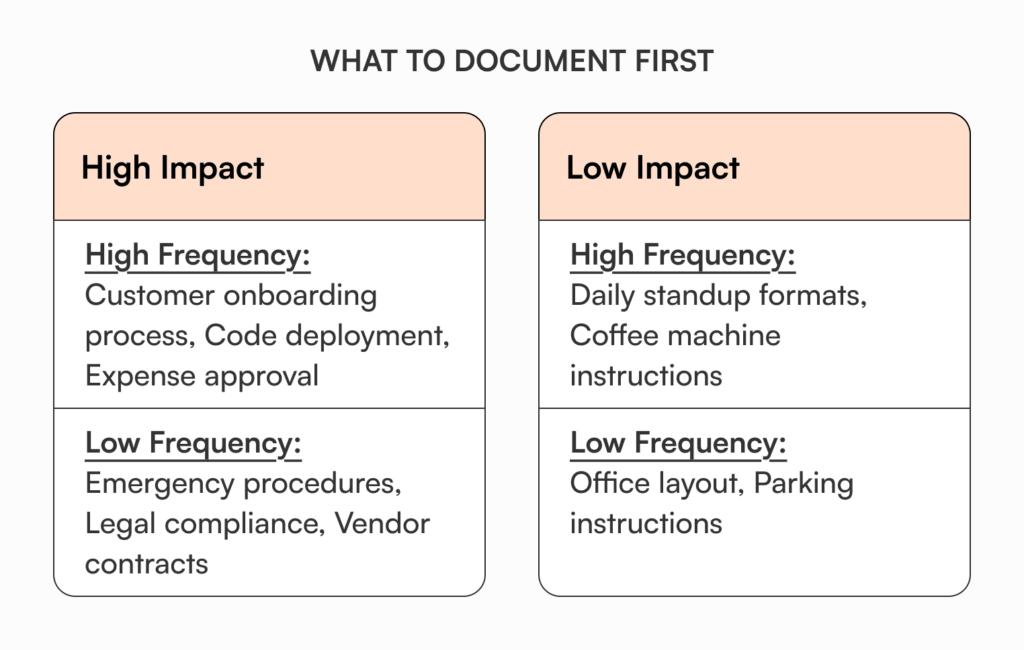At two employees, documentation feels like overkill. You sit across from your co-founder, decisions happen in real-time, and everyone knows everything because there’s only everything to know about. “Documentation” is your shared Google Drive and that Notion page you update sometimes.
At twenty employees, you’re drowning. New hires spend weeks figuring out basic processes. The same questions hit Slack every day. Your early employees have become information gatekeepers, not by choice but by necessity. Meetings multiply because no one can find written answers. And that casual “we’ll document it later” approach? It’s now actively slowing your growth.
The shift from 2 to 20 employees isn’t just about adding headcount. It’s about fundamentally changing how information flows through your company. Most startups miss this pivot, treating employee #20 like employee #3. They pay for it in velocity, culture, and sometimes company-breaking confusion.
The 10-employee inflection point
Something shifts around employee ten. It’s subtle at first, then suddenly overwhelming. Here’s what actually changes:
Information paths explode: With 2 people, there’s one communication path. With 10, there are 45. With 20, there are 190. The exponential growth of possible conversations means critical information gets stuck in random pockets.
Tribal knowledge becomes dangerous: When Sarah from customer success knows the refund process and Tom from engineering knows the deploy procedure, you have single points of failure everywhere. One sick day or vacation can grind entire workflows to a halt.
Context switching kills productivity: Your early employees become involuntary help desks. They spend half their day answering “quick questions” instead of doing the work you hired them for. Their expertise becomes a bottleneck rather than an asset.
Cultural dilution accelerates: Those unwritten cultural norms and informal processes that made you special? New hires can’t absorb them through osmosis anymore. Your culture starts fragmenting into mini-cultures around whoever onboarded whom.
Also read: Product Documentation for the Solo Founder & Startups
Why startups resist the documentation pivot
The resistance is real and understandable. When you’re moving fast, documentation feels like pumping the brakes. Common refrains include:
“We hire smart people who can figure things out.” True, but why make them? Every hour spent detective-working through your processes is an hour not spent on their actual job. Smart people want to contribute quickly, not archaeology their way through tribal knowledge.
“Things change too fast to document.” This assumes documentation must be perfect and permanent. In reality, documented processes that are 80% accurate beat undocumented processes every time. Update as you go rather than waiting for stability that never comes.
“We’re not corporate; we don’t need bureaucracy.” Documentation isn’t bureaucracy – it’s infrastructure. Like choosing good development tools or setting up proper IT systems, it’s what enables speed at scale, not what prevents it.
“Everyone prefers to just ask someone.” Of course they do, because the alternative doesn’t exist. But what happens when the person they need to ask is in a different timezone, on vacation, or has left the company?
The five documentation shifts that matter most
You don’t need to document everything. Focus on these five areas that cause the most friction as you scale:
From verbal to written decision-making
At 5 employees, decisions happen verbally and everyone’s in the room. At 20, half your team misses every decision. Document:
- What was decided
- Why it was decided (context future team members will lack)
- Who made the decision
- What other options were considered
Create a simple decision log. It doesn’t need to be fancy: “Date: Oct 15. Decision: Moving to quarterly planning. Why: Monthly cycles causing whiplash. Owner: Founders. Alternatives considered: 6-week cycles, staying monthly.”
From implicit to explicit processes
Early employees figure out processes by watching others. This breaks at scale. Critical processes to document:
- How to ship code (local setup, testing, deployment)
- How to handle customer issues (escalation paths, response times)
- How to get things approved (expenses, time off, new tools)
- How to onboard new customers (handoffs, timelines, deliverables)
Write these as you do them, not from memory. Next time you deploy code, document each step. It’s more accurate and takes less time than trying to recall later.
From meetings to asynchronous updates
Those daily standups with 5 people? They become 45-minute time sinks with 20. Shift to written updates:
- Weekly team updates (what shipped, what’s blocked, what’s next)
- Project status reports (progress, risks, needs)
- Experiment results (what we tried, what we learned, what’s next)
Template these updates so they’re consistent and scannable. “This week: Shipped X, Blocked on Y, Next week focusing on Z” beats lengthy prose.
From assumption to context
Early employees have context from being there at the beginning. New employees have none. Document:
- Why you built features certain ways (technical decisions)
- Why you chose specific markets or customers (strategic decisions)
- Why you have certain policies (cultural decisions)
- Why you killed certain initiatives (learning decisions)
This “why” documentation prevents relitigating old decisions and helps new folks understand the reasoning behind current reality.
From individual to shared knowledge
Your first engineer knows the entire codebase. Your first salesperson knows every customer quirk. This knowledge concentration becomes dangerous. Create:
- Technical runbooks (how systems work, common issues)
- Customer profiles (key contacts, preferences, history)
- Vendor relationships (who we work with, why, how)
- Institutional memory (failed experiments, learned lessons)

The goal isn’t comprehensive documentation; it’s eliminating single points of failure.
Building your 2-to-20 documentation system
Here’s how to make the pivot without grinding to a halt:
Start with pain points: What question did multiple people ask this week? What process caused confusion? What knowledge lives in only one person’s head? Document these first.
Write for your newest hire: They have the least context and highest need. If they can understand and use your documentation, everyone can. Have them review and identify gaps.
Timebox documentation efforts: Don’t aim for perfection. Set a timer for 30 minutes and document what you can. A rough guide beats no guide while you’re waiting for time to write the perfect version.
Make it discoverable: The best documentation is worthless if no one can find it. Create a simple index or table of contents. Use consistent naming. Put it where people already look for information.
Version control your evolution: Date your documentation and track changes. When processes evolve, don’t delete old versions – mark them as outdated and explain what changed. This helps people understand evolution, not just the current state.

Quick documentation priority check:
- Multiple people asked about this process this week → Document immediately
- Only one person knows how to do this → Document next
- Process works fine but isn’t written down → Document when time allows
- Process is written somewhere but hard to find → Improve discoverability first
The weekly documentation sprint
Implement a simple weekly practice that keeps documentation current:
- Monday: Identify one process that caused friction last week.
- Tuesday-Thursday: Document it as you do it.
- Friday: Share with the team, gather feedback, update.
This 30-minute weekly investment prevents documentation debt from accumulating. It also makes documentation a normal part of work, not a special project.
Measuring the impact
How do you know if your documentation pivot is working? Track these signals:
Onboarding velocity: How quickly can new hires contribute meaningfully? If it’s getting faster, your documentation is working.
Question repetition: Are the same questions hitting Slack less frequently? Good documentation should reduce repetitive asks.
Process consistency: Are different team members following the same processes? Documentation should create alignment without mandating rigidity.
Knowledge distribution: Can multiple people answer questions about key processes? You’re successfully distributing knowledge beyond original owners.
When basic documentation isn’t enough
As you approach 20 employees, managing documentation in scattered Google Docs becomes its own problem. You’ll face versioning issues, access control challenges, and no way to track who’s seen critical updates.
This is where purpose-built tools like AllyMatter help. Your documentation transitions from static files to a living system with proper version control, clear approval workflows for changes, and tracking of who’s acknowledged important updates. The goal is maintaining the accessibility that made documentation valuable while adding the structure that prevents chaos at scale.
Also read: DORA 2024: Building High-Performance Documentation
The compound benefits
Successfully pivoting your documentation approach from 2 to 20 employees creates compound benefits:
Faster scaling: When employee 21 joins, they’re productive in days not weeks. When you need to hire five people next month, you can.
Preserved culture: Your values and approaches are documented and shareable, not just lived by early employees. Culture scales through clarity, not proximity.
Reduced key person risk: No single person holds critical knowledge hostage. Vacations don’t cause crises. Departures don’t create knowledge voids.
Increased innovation: When people aren’t spending time on information archaeology, they can focus on building and creating. Documentation enables speed, not bureaucracy.
How AllyMatter supports your documentation pivot
Growing companies need more than scattered Google Docs to manage their knowledge effectively. AllyMatter’s centralized platform ensures your documentation stays organized, accessible, and current as you scale.
With role-based access control, your team members see exactly what they need without information overload. Smart approval workflows mean process changes get properly reviewed and communicated. Version tracking ensures nothing gets lost when procedures evolve.
The platform’s intelligent search helps new hires find answers quickly, reducing the burden on your existing team. Instead of becoming information gatekeepers, your early employees can focus on their actual work while knowledge flows freely throughout the organization.
Start today, thank yourself at 30 employees
The documentation pivot from 2 to 20 employees isn’t optional – it’s essential for sustainable growth. The only question is whether you’ll do it proactively or reactively, smoothly or painfully.
Start today with one simple action: Document the next process you do. Don’t overthink it. Just write down the steps as you do them. Share it with your team. Build the muscle of making implicit knowledge explicit.
Your 30-employee future self will thank you. More importantly, employees 21 through 30 will actually be able to contribute effectively from day one.
Ready to build documentation that scales with your startup? Join our waitlist.
Frequently asked questions
What’s the minimum documentation needed for a 10-person startup?
Focus on decision logs, core processes (code deployment, customer onboarding, expense approval), and basic onboarding materials. Don’t try to document everything – prioritize what causes the most repeated questions or confusion.
How do you prevent documentation from becoming outdated quickly?
Assign ownership to specific team members and build updates into existing workflows. When you change a process, update the documentation as part of the change, not as a separate task later.
Should startups use multiple tools for different types of documentation?
Consolidation is key at this stage. Having technical docs in one place, HR policies in another, and procedures scattered across various tools creates more problems than it solves. Choose one platform that can handle different content types.
How long should it take to document a process?
Use the 30-minute rule – if you can’t document a process in 30 minutes, it’s probably too complex and needs simplification first. Most processes can be captured in 10-15 minutes while you’re doing them.


